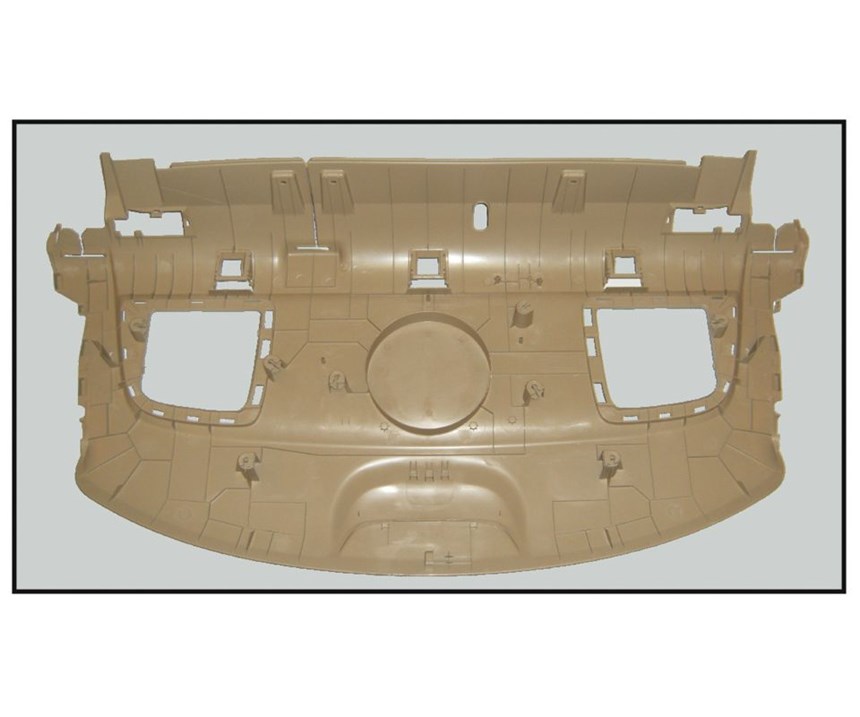Lessons Learned with Aluminum Tooling
Developing a team business plan and making changes to design, operation and maintenance procedures help increase the chances for a successful aluminum mold project.
#aluminum
Production aluminum tooling has become a cost-effective technology solution for the entire supply chain in high-volume automotive applications, freeing up production capacity, driving cycle-time reduction and reducing total program cost.
When properly executed, aluminum tooling brings massive efficiencies and cost savings to the molding process. First, consider this comparison: a steel mold designed to run 150,000 shots per year with a 50-second cycle time would need to run 95 days to produce the necessary 1,584 shots per day. Using a very conservative estimate, that same part in an aluminum mold would run a 35-second cycle time, so producing the same number of shots would only require 66 days. This equates to nearly 700 hours saved. In other words, the aluminum tooling has created free capacity. In addition, an aluminum mold is half the weight of a P-20 steel mold, resulting in less wear and tear on molding machines and crane equipment, which further saves a shop energy and other costs.
Featured Content
Despite these benefits, misconceptions still persist about the availability of aluminum grades suitable for high-volume molding projects and about aluminum’s effectiveness in high-volume and large-part applications. The wheel liner on the 2011 Honda Civic is a well-known project that serves as proof of the success of aluminum tooling in a high-volume application. The part for this project measured 44 by 13 by 24 inches, and the mold was cut from a forged 7000-series Alumold block measuring 70 by 52 by 31 inches, the largest block ever forged to produce a high-volume aluminum production injection mold. This mold withstood more than 597,000 shots before it was retired.
There are essential best practices for using aluminum as a mold material that only come with experience, however. For example, our shop has found that olefin materials (polypropylene, polyethylene and thermoplastic olefin) are best suited for aluminum tooling in higher volume applications. Crystalline materials with glass filler can also be used, but in our experience, the mold will wear more quickly.
The single most important best practice when making the move to aluminum tooling may be to develop a true partnership among the OEM, molder and mold builder involved in a project, establishing and sharing roles, responsibilities and expectations. Without buy-in from all parties, an aluminum mold project is less likely to succeed.
Change of Plans
A business plan can ease the execution of aluminum tooling throughout a customer’s supplier base, as it requires changes to a molder’s machine operating guidelines, and service and maintenance procedures. Training of molding personnel (or, more accurately, re-training, often led by an experienced mold builder) will be needed with the first job, because once the potential for a massive reduction in cycle time is realized, different production techniques may make sense, which in turn, can drive investment decisions.
For example, if the molder is producing a less complex part, it may make sense to limit the amount of secondary operations performed at the machine. The logic here is that the full benefit of the potential cycle-time savings can be realized, and then any secondary operations can be completed offline, at a different location in the plant.
When we built the mold for the Honda Accord’s rear deck 10 years ago, the mold was used in a production cell that was originally designed for a P-20 steel tool. While the aluminum tool produced an impressive 20-percent cycle-time savings over the course of nearly 900,000 shots before the tool was retired, the potential for even more significant cycle time savings was lost due to the number of secondary operations that were performed on the part in the cell. The molder would have needed to add more manpower at the cell to realize that additional time savings, but it chose not to do so.
Several design and processing considerations should be taken into account when building an mold from aluminum instead of a comparable steel, including:
• Establishing new operating press guidelines for presses that normally use steel molds. This requires working closely with the molder to test and set the new protocols which allow for the softer material’s different thermal expansion rates and thermal conductivity. If you’re an automotive molder using aluminum for the first time and you treat the aluminum like you would steel, you’ll likely fail.
• Adjusting the design of parting lines and the part’s periphery to help distribute the tonnage of the machine, despite the fact that aluminum’s compressive strength can easily withstand the rigors of the injection molding process.
• Distributing water differently to optimize its distribution within the tool.
• Engineering tool growth into the tooling. For example, changes in parting lines, locks and many other items need to be considered when using hybrid aluminum tooling because of the differences in each material’s coefficient of thermal expansion.
• Slightly increasing tool size to account for molding pressures.
The bottom line is that moldmakers today continue to fight against the oversimplified label of “supplier of commodities” placed upon them. One way to win that battle is to learn and become proficient in the design and construction of aluminum molds for high-volume automotive applications, which will bring significant added value to the production process.
RELATED CONTENT
-
Aluminum Welding
The use of aluminum tooling is becoming more common. Choosing the right wire and the right welding technique will produce the most effective mold repair.
-
Choosing Thermally Conductive Tooling Materials
By using alternative materials such as aluminum or copper-based alloys, moldmakers can help molders reduce or eliminate some molding problems down the road.
-
Vertical Machining Center Designed for Moldmaking Alongside Metal 3D Printers Brings Virus Face Masks to Market Quickly
Speed and accuracy of a new vertical machining center are vital to a two-process approach for quickly producing much-needed face mask molds.















